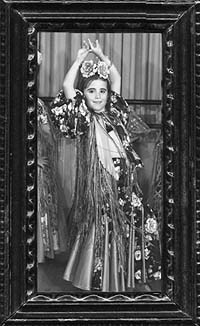
|
An interview with...
|
[Editor's note: in the summer of 1998, I produced a print version of this website, the Flamenco in DC newsletter. At the time, I was interviewing one local flamenco artist each month. Below is an excerpt from the interview that appeared in the July issue. Enjoy!]
Part 1 of 4 Saturday June 27, 1998--Alma Carmen Priego "la Terremoto" began her studies of Spanish dance at the age of 3 in Las Cabales Academy in Guadalajara, Mexico under the instruction of Lyla Barzee and Hilda Prats. After receiving her teaching degrees in 1983 and 1985, she taught extensively in Las Cabales and some other local groups before moving to the Washington DC area
Saturday June 27, 1998--Alma Carmen Priego "la Terremoto" began her studies of Spanish dance at the age of 3 in Las Cabales Academy in Guadalajara, Mexico under the instruction of Lyla Barzee and Hilda Prats. After receiving her teaching degrees in 1983 and 1985, she taught extensively in Las Cabales and some other local groups before moving to the Washington DC areaShe has studied with Joaquín Fajardo, Chuni Amaya in Guadalajara and with La Tati, Paco Romero and Azorin in Madrid and León, Spain. In 1988, she joined the Raquel Peña Spanish Dance Company. Since 1989 Ms Priego has been a principal dancer in Danza del Río. She is currently a guest dancer in Ziva's Spanish Dance Ensemble. In the Fall, Alma will move to New Jersey.
(Childhood photo courtesy of Alma.)
Flamenco in Guadalajara was great. We never competed. You just did your thing, you did your shows and we had people coming from Spain to cooperate with us and not be against each other. It's so different than here. You are raised to just follow the road. You get everything: technique, you get classes for anatomy, for how to put makeup on, how to get the cante. We would do classes for cante of course, we did a lot of cante in the shows, but the flamenco world in Mexico is nothing like this [here in DC]. It's very different. Besides, Guadalajara and Madrid are like sisters so everything that's going on in Madrid, happens in Guadalajara so we are pretty updated. The shows were amazing. The girls are trained from a very young age; I was two-and-a-half years old. And so you get a great teacher that knows a lot and takes you this way, you get a teaching degree and then you do the same thing. But then you get here [in DC] and you have school shows--I never did school shows in my life. What is that? When I came with Raquel Peña, she said to me "OK we're going to do shows." And I thought it was going to be like the flamenco that I had in Mexico which is unbelievable. In Mexico, we had all these people coming to perform with us. And I come here and the shows are really not [like the ones in Guadalajara]...but I still like it. So what was it like when you were taking classes as a beginner: was it all technique? It was all technique. Nothing else but technique. And also like the girl, who commented on your [DCFLAMENCO] website, I believe it's not how many choreographies you can learn, you need to get the technique too! Do a bunch of stuff, only one step, repeat it 10,000 times and one kind of arms and that's it, you'll have everything you [need]. You have one step and then from that step can be ten [variations]. You can make so much. So we had one hour for technique for brazos (arms) and also the movement of the fingers because you were never allowed to do a turn without using your fingers. I don't know how to explain it in English. Technique of the hands...Caracoleo de la flor. We just call it la flor (flower) because it looked like really really nice. It was technique for that and then technique for arms and technique even for the movement of the waist because you have to do that too. And then I remember doing [flamenco] tangos without shoes. It's just technique. You were focusing on the hips. Everything had to do with the mood. Tangos shouldn't even be dances with shoes. (laughs) If you do technique you can develop your own style. Did you parents force you to take classes? Yeah they did. Actually what happened was that all my sisters, four older and one younger, they all took classes. My father was the doctor of the director of the company of the studio and so he decided for us to dance and later everybody got married and had kids. I remember going to ballet because you had to have ballet, going to piano, going to flamenco, and I [got to the point] where I thought, "That's it!. I'm not doing anymore!" But I'm happy doing this stuff because my sisters all stopped and they now [say] "Oh no! So why didn't I continue? I could've been dancing with you!" But look, I have kids and I still dance. But it was fun. I used to spend all afternoon in the studio from 4 o'clock until 9. I used to teach from 4 to 6 and from 6 to 9 take classes. Everyday, Monday through Friday sometimes Saturdays, too. That's how I spent my years.
[Editor's note: Stay tuned for further excerpts. In the meantime, visit Alma's website at http://hometown.aol.com/flamenco99/page/index.htm]
|